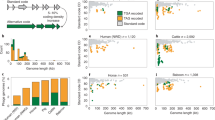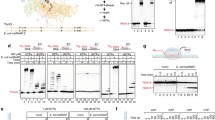Abstract
Translation initiation is governed by a limited number of mRNA sequence motifs within the translation initiation region (TIR). In bacteria and bacteriophages, one of the most important determinants is a Shine-Dalgarno (SD) sequence that base pairs with the anti-SD sequence GAUCACCUCCUUA localized in the 3′ end of 16S rRNA. This work assesses a diversity of TIR features in phage T4, focusing on the SD sequence, its spacing to the start codon and relationship to gene expression and essentiality patterns. Analysis shows that GAGG is predominant of all core SD motifs in T4 and its related phages, particularly in early genes. Possible implication of the RegB activity is discussed.




Similar content being viewed by others
References
Gold L (1988) Posttranscriptional regulatory mechanisms in Escherichia coli. Annu Rev Biochem 57:199–233
Kozak M (1999) Initiation of translation in prokaryotes and eukaryotes. Gene 234:187–208
Nakamoto T (2011) Mechanisms of the initiation of protein synthesis: in reading frame binding of ribosomes to mRNA. Mol Biol Rep. doi:10.1007/s11033-010-0176-1
Shine J, Dalgarno L (1974) The 3’-terminal sequence of Escherichia coli 16S ribosomal RNA complementarity to nonsense triplets and ribosome binding sites. Proc. Natl Acad Sci USA 71:1342–1346
Calogero R, Pon C, Canonaco M, Gualerzi C (1988) Selection of the mRNA translation initiation region by Escherichia coli ribosomes. Proc Natl Acad Sci USA 85:6427–6431
Hartz D, McPheeters DS, Green L, Gold L (1991) Detection of Escherichia coli ribosome binding at translation initiation sites in the absence of tRNA. J Mol Biol 218:99–105
Hartz D, McPheeters DS, Gold L (1991) Influence of mRNA determinants on translation initiation in Escherichia coli. J Mol Biol 218:83–97
Simonetti A, Marzi A, Jenner L, Myasnikov A, Romby P, Yusupova G, Klaholz BP, Yusupov M (2009) A structural view of translation initiation in Bacteria. Cell Mol Life Sci 66:423–436
Ringquist S, Shinedling S, Barrick D, Green L, Binkley J, Stormo GD, Gold L (1992) Translation initiation in Escherichia coli: sequences within the ribosome-binding site. Mol Microbiol 6:1129–1219
Vellanoweth RL, Rabinowitz JC (1992) The influence of ribosome binding site on translational efficiency in Bacillus subtilis and Escherichia coli in vivo. Mol Microbiol 6:1105–1114
de Smit MH, van Duin J (1994) Control of translation by mRNA secondary structure in Escherichia coli. A quantitative analysis of literature data. J Mol Biol 244:144–150
Draper DE, Gluick TC, Schlax PJ (1998) Pseudoknots, RNA folding and translational regulation. In: Simons RW, Grunberg-Manago M (eds) RNA structure and function. Cold Spring Harbor Laboratory Press, Cold Spring Harbor, NY, pp 415–436
Ma J, Campbell A, Karlin S (2002) Correlations between Shine-Dalgarno sequences and gene features such as predicted expression levels and operon structures. J Bacteriol 184:5733–5745
Kozak M (1983) Comparison of initiation of protein synthesis in prokaryotes, eukaryotes, and organelles. Microbiol Rev 47:1–45
de Smit MH, van Duin J (1994) Translational initiation on structured messengers. Another role for the Shine-Dalgarno interaction. J Mol Biol 235:173–184
Wagner LA, Gesteland RF, Dayhuff TJ, Weiss RB (1994) An efficient Shine-Dalgarno sequence but not translation is necessary for lacZ mRNA stability in Escherichia coli. J Bacteriol 176:1683–1688
Miller ES, Kutter E, Mosig G, Arisaka F, Kunisawa T, Ruger W (2003) Bacteriophage T4 genome. Microbiol Mol Biol Rev 67:86–156
Chen H, Bjerknes M, Kumar R, Jay E (1994) Determination of the optimal aligned spacing between the Shine-Dalgarno sequence and the translation initiation codon of Escherichia coli mRNAs. Nucleic Acids Res 22:4953–4957
Shultzaberger RK, Bucheimer RE, Rudd KE, Schneider TD (2001) Anatomy of Escherichia coli ribosome binding sites. J Mol Biol 313:215–228
Miller ES, Karam JD, Spicer E (1994) Control of translation initiation: mRNA structure and protein repressors. In: Karam JD et al (eds) Molecular biology of bacteriophage T4. American Society for Microbiology, Washington, DC, pp 193–205
Nivinskas R, Malys N, Klausa V, Vaiškūnaitė R, Gineikienė E (1999) Post-transcriptional control of bacteriophage T4 gene 25 expression mRNA secondary structure that enhances translational initiation. J Mol Biol 288:291–304
Malys N, Nivinskas R (2009) Non-canonical RNA arrangement in T4-even phages: accommodated ribosome binding site at the gene 26–25 intercistronic junction. Mol Microbiol 73:1115–1127
Sanson B, Hu R-M, Troitskaya E, Mathy N, Uzan M (2000) Endoribonuclease RegB from bacteriophage T4 is necessary for the degradation of early but not middle or late mRNAs. J Mol Biol 297:1063–1074
Durand S, Richard G, Bisaglia M, Laalami S, Bontems F, Uzan M (2006) Activation of RegB endoribonuclease by S1 ribosomal protein requires an 11 nt conserved sequence. Nucleic Acids Res 34:6549–6560
Zajančkauskaite A, Truncaite L, Strazdaite-Žieliene Ž, Nivinskas R (2008) Involvement of the Escherichia coli endoribonucleases G and E in the secondary processing of RegB-cleaved transcripts of bacteriophage T4. Virology 375:342–353
Piešiniene L, Truncaite L, Zajančkauskaite A, Nivinskas R (2004) The sequences and activities of RegB endoribonucleases of T4-related bacteriophages. Nucleic Acids Res 32:5582–5595
Malys N, McCarthy JEG (2011) Translation initiation: variations in the mechanism can be anticipated. Cell Mol Life Sci 68:991–1003
Markham NR, Zuker M (2005) DINAMelt web server for nucleic acid melting prediction. Nucleic Acids Res 33:W577–W581
Schurr T, Nadir E, Margalit H (1993) Identification and characterization of E. coli ribosomal binding sites by free energy computation. Nucleic Acid Res 21:4019–4023
Zajančkauskaite A, Malys N, Nivinskas R (1997) A rare type of overlapping genes in bacteriophage T4: gene 30.3’ is completely embedded within gene 30.3 by one position downstream. Gene 194:157–162
Liu H, He R, Zhang H, Huang Y, Tian M, Zhang J (2010) Analysis of synonymous codon usage in Zea mays. Mol Biol Rep 37:677–684
Zhou M, Li X (2009) Analysis of synonymous codon usage patterns in different plant mitochondrial genomes. Mol Biol Rep 36:2039–2046
Komarova AV, Tchufistova LS, Dreyfus M, Boni IV (2005) AU-rich sequences within 5′ untranslated leaders enhance translation and stabilize mRNA in Escherichia coli. J Bacteriol 187:1344–1349
Boni IV, Artamonova VS, Tzareva NV, Dreyfus M (2001) Non-canonical mechanism for translational control in bacteria: synthesis of ribosomal protein S1. EMBO J 20:4222–4232
Hering O, Brenneis M, Beer J, Suess B, Soppa J (2009) A novel mechanism for translation initiation operates in Haloarchaea. Mol Microbiol 71:1451–1463
Gray NK, Hentze MW (1994) Regulation of protein synthesis by mRNA structure. Mol Biol Rep 19:195–200
Vimberg V, Tats A, Remm M, Tenson T (2007) Translation initiation region sequence preferences in Escherichia coli. BMC Mol Biol 8:100
Uzan M, Miller ES (2010) Post-transcriptional control by bacteriophage T4: mRNA decay and inhibition of translation initiation. Virol J 7:360
Uzan M (2001) Bacteriophage T4 RegB endoribonuclease. Methods Enzymol 342:467–480
Uzan M (2009) RNA processing and decay in bacteriophage T4. Prog Mol Biol Trans Sci 85:43–89
Acknowledgments
The author is grateful to anonymous reviewers for constructive and critical comments. N.M. acknowledges the support of the BBSRC/EPSRC Grant BB/C008219/1 “The Manchester Centre for Integrative Systems Biology (MCISB)”.
Author information
Authors and Affiliations
Corresponding author
Electronic supplementary material
Below is the link to the electronic supplementary material.
Rights and permissions
About this article
Cite this article
Malys, N. Shine-Dalgarno sequence of bacteriophage T4: GAGG prevails in early genes. Mol Biol Rep 39, 33–39 (2012). https://doi.org/10.1007/s11033-011-0707-4
Received:
Accepted:
Published:
Issue Date:
DOI: https://doi.org/10.1007/s11033-011-0707-4




